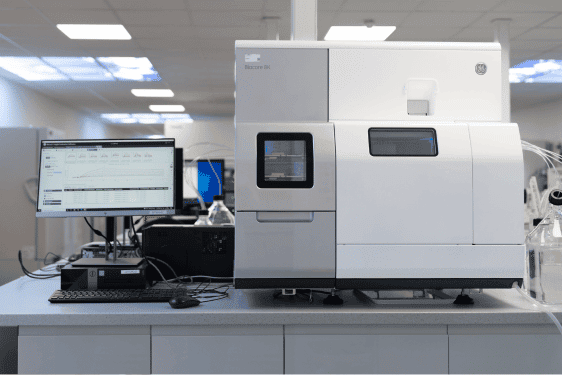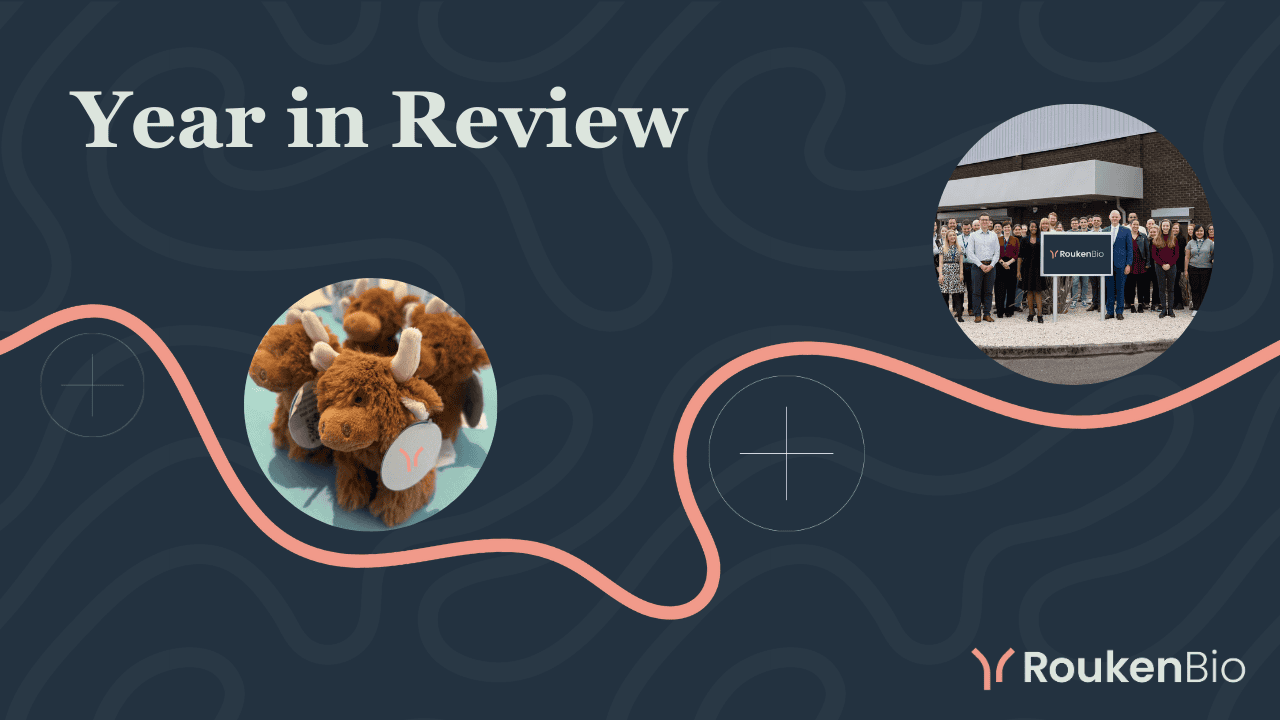We solve problems. We deliver quality data. We take your project to the next milestone. We are RoukenBio.
79
Net Promoter Score - our clients love working with us
27
Countries with customers globally

100+
Employees and growing
484
square meters of lab space with state-of-the-art instruments

Solutions
RoukenBio provides drug development services to support a global customer base to develop small molecule, large molecule and advanced therapeutics from early discovery through to clinical phases.
Phase
RoukenBio supports innovative biotechnology companies from the earliest phases of drug discovery through to clinical development. Our decades of academic expertise are combined with hands-on, practical industry experience of driving large molecule and advanced therapies forward.
Learn more
Modalities
Our multidisciplinary team of scientific experts are seasoned at supporting the development of a wide range of therapeutic modalities, possessing knowledge of the unique challenges associated across these classes. Our collective accomplishments across different therapeutic areas, combined with our state-of-the-art assay platforms and custom development capabilities, makes us the perfect partner for your drug development journey.
Explore all modalities
Therapeutic focus
At RoukenBio, our experience spans across a diverse range of therapeutic fields, making us the premier partner for the development of innovative therapies. We translate this into actionable strategies that ensure we comprehend the critical elements of disease biology that are relevant to your therapeutic goals, allowing us to grasp the nuances of what you are trying to achieve at each stage.
Explore our therapeutic expertise
Capabilities
Discover our cutting-edge service areas, innovative assays, novel tools and state-of-the-art equipment designed to propel your drug discovery and research breakthroughs.
Service Areas
We offer high-quality solutions to enhance the development of therapeutics across the drug development life cycle. Created by experts in their respective fields and crafted to address the unique challenges arising from the evolving complexity of today's modalities, we deliver services based upon cutting-edge assay design, advanced platforms, patented technologies and sophisticated equipment, making us the partner of choice for your therapeutic development needs. Our collaborative research services encompass a broad spectrum of activities tailored to support agile needs arising from an ever-changing industry landscape.
Explore all service areas
Assays
Explore our innovative assays, offering tailored solutions to drive your research forward with precision and reliability. Inspired by possibility, we embrace challenges as catalysts for innovation. So, when the landscape shifts and many are struggling to maintain their balance, we’re always looking for novel solutions to implement giving your project the edge.
Gain the edge with our assays
Equipment
At RoukenBio, we use state-of-the-art equipment to deliver precise and reliable scientific data. Our team of brilliant minds is trained to optimally operate these advanced systems, providing you with high-quality results tailored to your specific research needs. We are an agile collaborative research partner ready for tomorrow that’s also reflected in the choice of equipment in our labs.
Get to know our instruments
Backed by Brilliant Minds
Our vision is to become the most trusted research partner for biotherapeutic innovators.
Meet our brilliant minds


What our customers say
Explore genuine feedback and testimonials from our clients.
"It has been a pleasure working closely with RoukenBio to evaluate the functional activity of our IgM antibodies in ex vivo primary cell assays. The scientific team at RoukenBio feels like an extension of our internal Preclinical Sciences team since they readily provide trouble-shooting input. Through multiple successful collaborations, RoukenBio has consistently delivered high quality, robust data. I highly recommend working with them!"
Maya Kotturi, Ph.D
Executive Director - Translational Research
"We initially reached out to RoukenBio 3 years ago to run intricate cell-based assays using primary immune cells; the company had come highly recommended by former colleagues. We were impressed right away by the depth of knowledge of the RoukenBio team and appreciated their input on our proposed experimental plans; the RoukenBio team excelled both at communicating and executing the work. I would highly recommend working with RoukenBio."
Bijan Etemad-Gilbertson, Ph.D
Vice President - Antibody Technology - NextPoint Therapeutics
"We appreciate the consultative approach that RoukenBio uses, working closely with us to truly understand our needs prior to engaging. This model results in a highly customized offering, quick response times when challenges arise, and timely delivery of high-quality research services. Speed and reliability are important to us as we strive to create a healthier world through affordable biologic medicines."
Dr. Claudia Wiza
Manager – Functional Assays
"Collaborating with RoukenBio is like a natural extension of our internal team. The level at which RoukenBio inputs and buys into the project, along with their attention to close communication and detail, is not something we experience with other CROs and are key factors that drive project success."
Emily Corse, Ph.D.
Executive Vice President, Biology & Translation
"We have worked with RoukenBio for approximately 3 years to run various immune cell based functional assays that our teams did not have the capabilities or capacity to run. We have been delighted with the quality of data, the clear collaborative communication and troubleshooting that RoukenBio has provided over the years and we look forward to continuing to work with them in our drug development processes."
Dr Angus Sinclair
Executive Vice Principle Research
"I am extremely pleased with the service provided by RoukenBio. Their team is incredibly knowledgeable, ensuring that all my questions are answered thoroughly. They are also highly efficient with their time, making the entire process smooth and hassle-free. Most importantly, their customer-oriented approach makes me feel valued and well taken care of. Highly recommended!"
Arnab Bera
Manager ARD Potency and Binding
"It has been a pleasure working closely with RoukenBio to evaluate the functional activity of our IgM antibodies in ex vivo primary cell assays. The scientific team at RoukenBio feels like an extension of our internal Preclinical Sciences team since they readily provide trouble-shooting input. Through multiple successful collaborations, RoukenBio has consistently delivered high quality, robust data. I highly recommend working with them!"
Maya Kotturi, Ph.D
Executive Director - Translational Research
"We initially reached out to RoukenBio 3 years ago to run intricate cell-based assays using primary immune cells; the company had come highly recommended by former colleagues. We were impressed right away by the depth of knowledge of the RoukenBio team and appreciated their input on our proposed experimental plans; the RoukenBio team excelled both at communicating and executing the work. I would highly recommend working with RoukenBio."
Bijan Etemad-Gilbertson, Ph.D
Vice President - Antibody Technology - NextPoint Therapeutics
"We appreciate the consultative approach that RoukenBio uses, working closely with us to truly understand our needs prior to engaging. This model results in a highly customized offering, quick response times when challenges arise, and timely delivery of high-quality research services. Speed and reliability are important to us as we strive to create a healthier world through affordable biologic medicines."
Dr. Claudia Wiza
Manager – Functional Assays
"Collaborating with RoukenBio is like a natural extension of our internal team. The level at which RoukenBio inputs and buys into the project, along with their attention to close communication and detail, is not something we experience with other CROs and are key factors that drive project success."
Emily Corse, Ph.D.
Executive Vice President, Biology & Translation
"We have worked with RoukenBio for approximately 3 years to run various immune cell based functional assays that our teams did not have the capabilities or capacity to run. We have been delighted with the quality of data, the clear collaborative communication and troubleshooting that RoukenBio has provided over the years and we look forward to continuing to work with them in our drug development processes."
Dr Angus Sinclair
Executive Vice Principle Research
"I am extremely pleased with the service provided by RoukenBio. Their team is incredibly knowledgeable, ensuring that all my questions are answered thoroughly. They are also highly efficient with their time, making the entire process smooth and hassle-free. Most importantly, their customer-oriented approach makes me feel valued and well taken care of. Highly recommended!"
Arnab Bera
Manager ARD Potency and Binding
Discover our news
Read more about the latest news at RoukenBio.


News Announcements
RoukenBio’s Year in Review
December 17, 2024 |4 min read


Employee News
Interview with our Summer Intern
December 5, 2024 |4 min read


Awards and Nominations
RoukenBio Wins SelectScience Webinar of the Year
August 15, 2024 |3 min read


